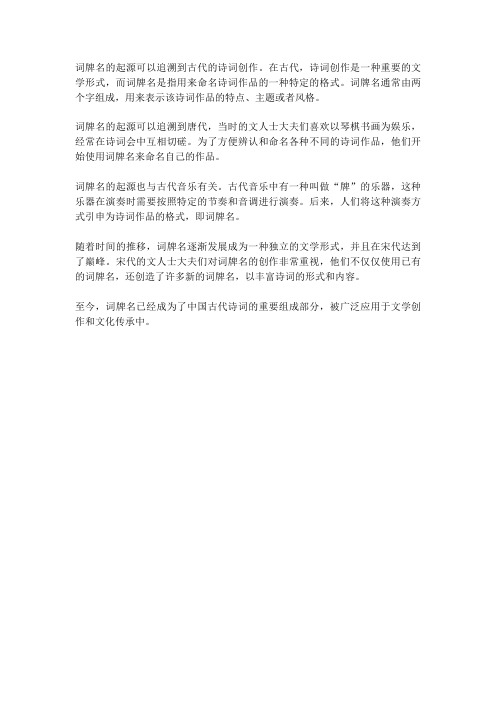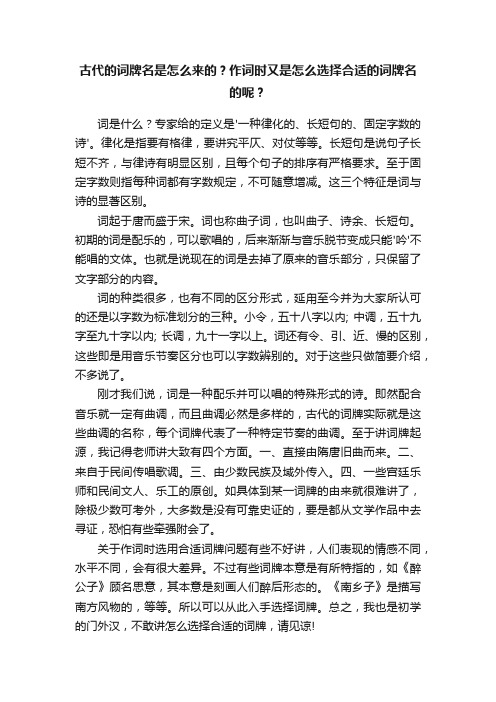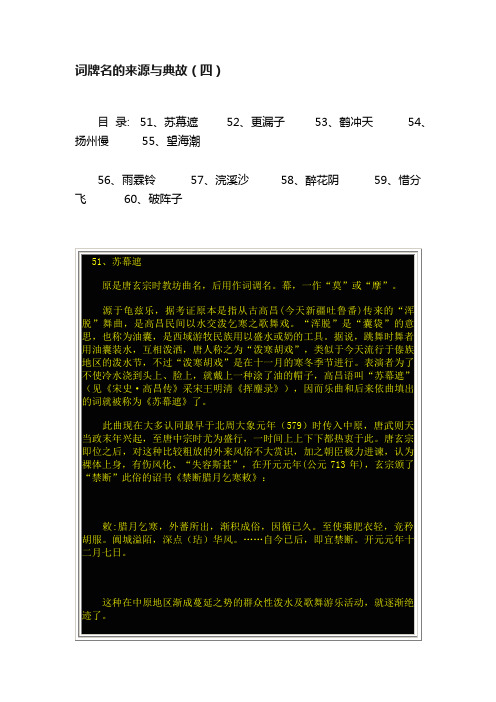中国古代词牌名的文化起源及翻译
五十个词牌名的来历

五十个词牌名来历中国的古典词牌名,每一个背后都有一段历史,一个故事。
自然与情感的交融【雨霖铃】因唐玄宗在安史之乱逃入蜀地,霖雨连下,栈道铃声中思念杨贵妃而制曲。
【鹧鸪天】由北宋宋祁首创,晏殊填词最多,别名众多如《千叶莲》、《思佳客》。
【菩萨蛮】源自女蛮国入贡的《菩萨蛮曲》,文士声其词。
【清平乐】唐教坊曲名,结合“清乐”、“平乐”命名,亦有别名《清平乐令》、《醉东风》。
【鹊桥仙】欧阳修词中有“鹊迎桥路接天津”,或因牛郎织女相会而得名。
【一剪梅】来自周邦彦“一剪梅花万样娇”,也称《玉簟秋》、《腊梅香》。
历史与文化的印记【南歌子】源自张衡《南都赋》“坐南歌兮起郑舞”。
【六州歌头】原唐代鼓吹曲,六州指伊、凉、甘、石、氐、渭,各有歌曲。
【惜奴娇】出自《高丽史乐志》宋赐大晟乐。
【行路难】古乐府杂曲歌名,多写世途艰难。
【渔家傲】取自晏殊“神仙一曲渔家傲”,有多个别名。
【昭君怨】词牌名,最早可能为昭君所创,见于苏轼《东坡词》。
艺术与灵感的结晶【水龙吟】取自李白“笛奏龙吟水”。
【霜天晓角】又名《月当窗》、《踏月》,首见于《全芳备祖前集》。
【临江仙】原唐教坊曲名,最初咏水仙。
【蝶恋花】原唐教坊曲名,取自梁简文帝“翻阶峡蝶恋花情”。
【西江月】调名取自李白《苏台览古》。
【虞美人】唐教坊曲名,后为词调,取名于项羽宠姬虞美人。
权力与荣耀的象征【沁园春】沁园本为汉代沁水公主园林。
【水调歌头】相传隋炀帝开汴河时制《水调歌》,唐人演为大曲。
【苏幕遮】原曲源自西域龟兹国。
【忆秦娥】相传李白首制此词,中有“秦娥梦断秦楼月”句。
【醉落魄】唐玄宗封珍珠一斛密赐江妃,江妃不受,后人以新声唱之。
【天仙子】原唐教坊曲名,本名《万斯年》,后因皇甫松词句改名。
每一个词牌都是一个故事,一段历史。
下次当你读到这些词牌的时候,不妨想想它们背后的故事,感受那份来自古代的情怀和艺术。
古代词牌名的渊源

古代词牌名的渊源
所谓词牌,就是词的曲调名称。
词牌总共有一千多个。
初期的词,曲调与内容每每是一致的,如白居易的《忆江南》三首。
到了后来,曲调、内容才分开,词牌只标明曲调,不再作为题目。
词牌的由来,尽管纷繁复杂,但也不外乎以下几种情况:
一是取于原本的乐曲名称。
如“清平乐”,它是汉代乐府中清乐与平乐两种乐调。
“菩萨蛮”相传是唐朝宣宗大中初年,女蛮国使者梳着高高的发髻,戴着金冠,满身佩挂珠宝,像菩萨般来大唐帝国进贡。
当时的音乐机关-----教坊,谱成“菩萨蛮”曲来款待使者,后来,“菩萨蛮”也就成了词牌。
二是截取词中名句命名。
“忆秦娥”,李白用这个格式写出了第一首词,词中有“箫声咽,秦娥望断秦楼月”的句子,词牌“忆秦娥”由此得名。
“蝶恋花”是从南梁简文帝词句“翻阶蛱蝶恋花情”而来。
三是原来就是词的题目。
如“浪淘沙”咏淘金人的劳动生活,“踏歌词”是一种合着脚步歌唱的曲调。
“抛球乐”说的是抛绣球等。
四是直接用词的字数来命名。
“十六字令”全词共十六个字。
“百字令”全词共一百个字。
五是以人名、事物名或故事为背景作词牌的。
如“沁园春”,据说东汉明帝女儿沁水公主有座园林,名为“沁园”,后被外戚窦宪仗势夺去,有人作词咏此事,词牌“沁园春”也就产生了。
“念奴娇”因唐明皇有个歌女名念奴而得名。
“浣溪沙”亦作“浣溪纱”,以春秋时西施浣纱的故事为背景而得名。
古代词牌名称及其特色介绍

古代词牌名称及其特色介绍一、词牌的定义与起源1.词牌是指古代词的音乐谱式,包括词的格律、韵脚、字数、节奏等。
2.词牌起源于唐代,盛行于宋代,是文人墨客进行创作的重要依据。
3.词牌分为“令”、“引”、“近”、“慢”等不同类别,其中“令”指短曲,“引”指延长曲调,“近”指近代曲调,“慢”指缓慢的曲调。
二、古代著名的词牌及其特色1.《水调歌头》:又名《水调》,源于唐代,盛行于宋代,曲调优美,词句豪放,多表达对美好生活的向往。
2.《满江红》:源于唐代,曲调激昂,节奏紧凑,多表现豪情壮志。
3.《念奴娇》:源于唐代,曲调悠扬,词句柔美,多表达对远方亲人的思念。
4.《声声慢》:源于宋代,曲调缓慢,词句凄美,多表达忧伤情绪。
5.《青玉案》:源于唐代,曲调清新,词句雅致,多描绘自然景色。
6.《乌衣巷》:源于唐代,曲调古朴,词句含蓄,多表达对往事的回忆。
7.《凤凰台上忆吹箫》:源于唐代,曲调优美,词句华丽,表达对美好时光的怀念。
8.《长相思》:源于唐代,曲调婉转,词句细腻,多表达离别之情。
9.《相见欢》:源于唐代,曲调欢快,词句热情,多表现喜悦心情。
10.《如梦令》:源于唐代,曲调梦幻,词句深情,多表达对美好事物的向往。
三、词牌的创作与运用1.词牌创作要求遵循一定的格律、韵脚、字数和节奏,体现音乐与文学的完美结合。
2.词牌在创作过程中,文人墨客可根据自己的情感需求,对曲调进行变奏、改编,使词牌更具个性化和独特性。
3.词牌在古代文学作品中广泛运用,如诗词、戏曲、小说等,成为古代文学的重要组成部分。
四、词牌的价值与影响1.词牌是古代音乐、文学艺术的瑰宝,传承了中华民族优秀的文化传统。
2.词牌丰富了古代文学的题材和表现手法,为后世文学创作提供了宝贵经验。
3.词牌在现代仍具有一定的研究和欣赏价值,对于弘扬民族文化、提高人们审美情趣具有重要意义。
总结:古代词牌名称及其特色介绍,涵盖了词牌的定义、起源、著名词牌及其特色、创作与运用以及价值与影响等方面的内容。
词牌名的起源

词牌名的起源可以追溯到古代的诗词创作。
在古代,诗词创作是一种重要的文学形式,而词牌名是指用来命名诗词作品的一种特定的格式。
词牌名通常由两个字组成,用来表示该诗词作品的特点、主题或者风格。
词牌名的起源可以追溯到唐代,当时的文人士大夫们喜欢以琴棋书画为娱乐,经常在诗词会中互相切磋。
为了方便辨认和命名各种不同的诗词作品,他们开始使用词牌名来命名自己的作品。
词牌名的起源也与古代音乐有关。
古代音乐中有一种叫做“牌”的乐器,这种乐器在演奏时需要按照特定的节奏和音调进行演奏。
后来,人们将这种演奏方式引申为诗词作品的格式,即词牌名。
随着时间的推移,词牌名逐渐发展成为一种独立的文学形式,并且在宋代达到了巅峰。
宋代的文人士大夫们对词牌名的创作非常重视,他们不仅仅使用已有的词牌名,还创造了许多新的词牌名,以丰富诗词的形式和内容。
至今,词牌名已经成为了中国古代诗词的重要组成部分,被广泛应用于文学创作和文化传承中。
古代的词牌名是怎么来的?作词时又是怎么选择合适的词牌名的呢?

古代的词牌名是怎么来的?作词时又是怎么选择合适的词牌名的呢?词是什么?专家给的定义是'一种律化的、长短句的、固定字数的诗'。
律化是指要有格律,要讲究平仄、对仗等等。
长短句是说句子长短不齐,与律诗有明显区别,且每个句子的排序有严格要求。
至于固定字数则指每种词都有字数规定,不可随意增减。
这三个特征是词与诗的显著区别。
词起于唐而盛于宋。
词也称曲子词,也叫曲子、诗余、长短句。
初期的词是配乐的,可以歌唱的,后来渐渐与音乐脱节变成只能'吟'不能唱的文体。
也就是说现在的词是去掉了原来的音乐部分,只保留了文字部分的内容。
词的种类很多,也有不同的区分形式,延甪至今并为大家所认可的还是以字数为标准划分的三种。
小令,五十八字以内; 中调,五十九字至九十字以内; 长调,九十一字以上。
词还有令、引、近、慢的区别,这些即是用音乐节奏区分也可以字数辨别的。
对于这些只做简要介绍,不多说了。
刚才我们说,词是一种配乐并可以唱的特殊形式的诗。
即然配合音乐就一定有曲调,而且曲调必然是多样的,古代的词牌实际就是这些曲调的名称,每个词牌代表了一种特定节奏的曲调。
至于讲词牌起源,我记得老师讲大致有四个方面。
一、直接由隋唐旧曲而来。
二、来自于民间传唱歌调。
三、由少数民族及域外传入。
四、一些宫廷乐师和民间文人、乐工的原创。
如具体到某一词牌的由来就很难讲了,除极少数可考外,大多数是没有可靠史证的,要是都从文学作品中去寻证,恐怕有些牵强附会了。
关于作词时选用合适词牌问题有些不好讲,人们表现的情感不同,水平不同,会有很大差异。
不过有些词牌本意是有所特指的,如《醉公子》顾名思意,其本意是刻画人们醉后形态的。
《南乡子》是描写南方风物的,等等。
所以可以从此入手选择词牌。
总之,我也是初学的门外汉,不敢讲怎么选择合适的词牌,请见谅!。
词牌名的来源与典故(四)

注:此词牌与《喜迁莺》之别名《鹤冲天》者无涉。
54、扬州慢
又名《朗州慢》。此调是宋姜夔过扬州时自度之曲,内容是写扬州在战乱后的破败景象和自己的感慨。
见其《白石道人歌曲》。其自序云:“淳熙丙申至日,予过维扬,夜雪初霁,荠麦弥望。入其城则四顾萧条,寒水自碧。暮色渐起,戍角悲吟。予怀怆然,感慨今昔,因自度此曲,千岩老人以为有《黍离》之悲也。”
唐·慧琳《一切经音义》卷四一:苏莫遮,西戎胡语也,正云“飒□遮”。此戏本出西龟兹国,至今犹有此曲,此国(指中国)浑脱、大面、拨头之类也。或作兽面,或象鬼神,假作种种面具形状;或以泥水沾洒行人;或持罥索搭钩,捉人为戏。每年七月初,公行此戏,七日乃停。土俗相传云:常以此法禳厌,驱趁罗刹恶鬼食啖人民之灾也。
敕:腊月乞寒,外蕃所出,渐积成俗,因循已久。至使乘肥衣轻,竞矜胡服。阗城溢陌,深点(玷)华风。……自今已后,即宜禁断。开元元年十二月七日。
这种在中原地区渐成蔓延之势的群众性泼水及歌舞游乐活动,就逐渐绝迹了。
不过呢,咱中国人自古以来都是身体力行上有政策,下有对策的,所以虽然颁布了禁断令,但泼寒胡戏却并未退出历史舞台。
这是首恭贺举子登第的作品。古代知识分子为猎取功名利禄,流落他乡,寒窗苦读,一旦科举录取,人生命运即刻改变,苦尽甘来。但也有一些人一事无成,“未老莫还乡,还乡须断肠”(韦庄《菩萨蛮》)却又不甘心被埋没。于是便出现了“柳永现象”。
1005年他来到汴京城参加科举考试,直到景佑元年(1034年)才中进士。其中有录用的可能,只可惜时不待他。
话说,如果是我,我也这样做。没考上,不去好好反思自身的不足,依旧自视甚高;明明一介布衣,却自个把自个当白衣卿相;最不能让人忍受的是“忍把浮名,换了浅斟低唱”,既然你这么看不上“浮名”,那就成全你算了。
词牌名的来源与典故

词牌名的来源与典故成语典故大家都知道吧,那成语都有哪些典故呢?下面是店铺带来的词牌名的来源与典故的内容,希望对大家有帮助词牌名的来源与典故11、菩萨蛮说完《忆秦娥》,我们来说说和它并为词中最古者的《菩萨蛮》。
本是唐代教坊曲名,《宋史·乐志》:女弟子舞队名。
菩萨蛮·李白平林漠漠烟如织,寒山一带伤心碧。
暝色入高楼,有人楼上愁。
玉阶空伫立,宿鸟归飞急。
何处是归程?长亭更短亭。
《菩萨蛮》作为词牌据传最先是李白所作,但有人怀疑是伪作。
李白是生于公元701年,卒于762年,而唐宣宗大中年代为公元846-859年。
明代胡应麟《少室山房笔丛·庄岳委谈下》则认为:“《菩萨蛮》曲调为唐宣宗大中初年因女蛮国入贡而编创的,则李白当时还无此曲调,自不可能有此词作”。
【唐苏鄂《杜阳杂编》云:大中初,女蛮国入贡,危髻金冠,缨络被体,号菩萨蛮队,当时倡优遂制《菩萨蛮》曲,文士亦往往声其词。
(大中:唐宣宗年号)】【五代孙光宪《北梦琐言》云:唐宣宗爱唱《菩萨蛮》词,令狐绹命温庭筠新撰进之。
】不过据《教坊记》著录,唐玄宗李隆基开元(713年—741年)、天宝(742年—756年)间已有《菩萨蛮》曲名,敦煌民间词中也有《菩萨蛮》词作。
《教坊记》是中国古代音乐著作,唐代崔令钦著,书成于唐肃宗李亨宝应元年(公元762年)。
从开元后期(公元740年左右)到宝应元年(公元762年左右),前后只是二十多年,由此可见崔令钦所记是可靠的。
这样的话李白写作《菩萨蛮》词时间上就有可能了。
另有宋僧文莹之《湘山野录》载:平林漠漠烟如织,寒山一带伤心碧。
暝色入高楼,有人楼上愁。
玉阶空佇立,宿鸟归飞急。
何处是归程,长亭连短亭。
此词写于鼎州沧水驿,不知何人所作,魏道辅泰见而爱之。
后至长沙,得古风集于曾子宣内翰家,乃知李白所撰。
《菩萨蛮》的成名还有另一种说法:唐许棠《奇男子传》及《太平广记》一六六“吴保安”条引《纪闻》,皆述郭仲翔随征南诏,李蒙军败,陷于菩萨蛮洞为奴,于天宝十二载逃归,调名之出与此有关。
唐宋词中词牌名英译

词是韵⽂⽂体之⼀,⼜称'曲⼦词',即歌词。
它本来是为配乐歌唱⽽写的诗。
由于它是配乐歌唱的,所以每⾸词都有或⾄少曾经有过⼀个乐谱。
每个乐谱都必定属于某种宫调(类似今天的C调、G调之类),有⼀定的旋律、节奏,这些东西的总和就是词调。
每种词调都有⼀个名称(如《西江⽉》、《清平乐》),这个名称就叫词牌。
词始于唐,盛于宋,是⼀种脍炙⼈⼝的⽂学表达形式,历来为⼈们所钟爱。
为把中华⽂化中这⼀绮丽的瑰宝译介到国外,不少译者已进⾏了⼤量开拓性的艰⾟劳动,其中不乏精美传神叹为观⽌之作。
然⽽,词的翻译⽐之散⽂⼩说确似更难,尤其是词牌名的翻译。
尽管就⼤多数词作来说,词牌与⾳乐或词中的内容关系不⼤,作者填词时,只视哪种词调形式更符合⾃⼰的需要,完全可以不去考虑词牌名称的原有含义和原来词曲的内容。
因此词牌在⼀般意义上不过是标明作者依哪⼀种现成的曲谱进⾏填词⽽已。
然⽽将词牌名译成英⽂时就不能不在传达词牌的神韵和美感的同时考虑它的历史来源和反映在其中的格律了。
下⾯试就词牌的⼏种常见的英译⽅法略抒浅见。
⼀、⼀般性词牌名的译法⼀般性词牌名没有什么历史典故,或有,但已⽆从考证,或取⾃前⼈的某个词句,或只是⼀个风雅的名词⽽已。
在这种情况下,按字⾯意思直译成英⽂,即可较好地保留原⽂的风格,传达原⽂的神韵和美感形象。
例如:鹧鸪天 Partridge Sky踏莎⾏ Treading On Grass相见欢 Joy At Meeting点绦唇 Rouged Lips满江红 The River All Red模鱼⼉ Groping For Fish楼 The Highest Tower疏影 space Shadows⽟楼春 Spring In Jade Pavilion昼夜乐 Joy Of Day And Night西江⽉ The Moon Over The West River风⼊松 Wind Through Pines双双燕 A Pair Of Sparrows⼆、'歌'、'词'、'歌头'、'吟'等词牌名的译法1.常带'歌'、'词'、'⼦'的词牌,不妨直译成'Song',既简单明了,⼜贴切⾃然。
- 1、下载文档前请自行甄别文档内容的完整性,平台不提供额外的编辑、内容补充、找答案等附加服务。
- 2、"仅部分预览"的文档,不可在线预览部分如存在完整性等问题,可反馈申请退款(可完整预览的文档不适用该条件!)。
- 3、如文档侵犯您的权益,请联系客服反馈,我们会尽快为您处理(人工客服工作时间:9:00-18:30)。
收稿日期:2005-09-18作者简介:郭姗姗,女,助教,研究方向:翻译及修辞。
第21卷第4期徐州工程学院学报2006年4月V ol.21N o.4Jour na l o f X uzho u Institute of T ech no lo gyA PR.2006中国古代词牌名的文化起源及翻译郭姗姗(徐州工程学院, 江苏 徐州 221008) 【摘 要】 中国诗歌史上最具影响力和代表性的就属唐诗宋词.每首词都有词牌,词牌种类丰富,蕴含着隽永的文化气息,有着不同的文化来源。
有些词牌不能根据字面直译,应在考释它的文化起源后再动笔。
【关键词】 词牌名;翻译;文化来源【中图分类号】 H059 【文献标识码】A 【文章编号】1673-0704(2006)04-0044-03中国诗歌史上最具影响力和代表性的就属唐诗宋词。
字里行间,处处珠玑,是中国千年来的文化积淀。
其自身也经历了历史的沉积和变迁,容入人们的文化生活,成为文化密不可分的一部分。
词牌,就是词的格式的名称。
词的格式和律诗的格式不同:律诗只有四种格式,而词则总共有一千多个格式(这些格式称为词谱)。
人们不好把它们称为第一式、第二式等等,所以给它们起了一些名字。
这些名字就是词牌。
有时候,几个格式合用一个词牌,因为它们是同一个格式的若干变体;有时候,同一个格式而有几个名称,那只因为各家叫名不同罢了。
尽管就大多数词作来说,词牌与音乐或词中的内容关系不大,作者填词时,只视哪种词调形式更符合自己的需要,完全可以不去考虑词牌名称的原有含义和原来词曲的内容。
因此词牌在一般意义上不过是标明作者依哪一种现成的曲谱进行填词而已。
然而将词牌名译成英文时就不能不在传达词牌的神韵和美感的同时考虑它的历史来源和反映在其中的格律了。
一、婉约词在北宋时几乎是一统天下,其词牌的选择也偏好选择咏、歌、吟等一般词牌名以供宴会场合伶工歌女吟唱,或用来展现当时的的生活情景,尤以男女爱情为主。
此类词牌中常有“歌”、“词”、“子”,都可以直译成“Song ”,或者“chant ”既简单明了,又贴切自然。
而词牌中带“吟”的一类与词牌为“歌”、“词”、“子”的相比,意思都是一样的,只是给人的感觉更为优雅,更为自在更为放松,在吟颂时音调较为平缓而从容。
例如:归朝歌So ng of Returning to The Mo rning Sta r洞仙歌Song Of A Fairy In The Cav e 柳枝词Willow Branch So ng 卜算子Song Of Divination南乡子Song o f Southern County 天仙子Song Of Imm ortal 赤枣子Song o f Red Jujubes更漏子Song Of Wa ter Clock At Nig ht 南歌子A Southern So ng 水龙吟Water Drag on Cha nt 瑞龙吟Auspicious Drago n Chant 水调歌头Prelude To Water M elody二、还有一些词牌名的文化起源已无从考证,更有一些部分是取自取某位词人的某个词句,或只是当时一些风雅时髦现象的一个代名词而已。
这种情况下按字面意思直接译成英文即可。
例如:模鱼儿Groping Fo r Fish 风入松Wind Throug h Pines 满江红The Riv er All Red·44·寻芳草Founding Greens踏莎行Treading On Grass双双燕A Pair Of Sparrow s相见欢Joy At M eeting西江月The Mo on Ov er The West Riv er玉楼春Spring In Jade Pavilio n昼夜乐Joy Of Day And Nigh t点绦唇Roug ed Lips鹧鸪天Partridge Sky最高楼The H ig hest Tow er疏影space Shadow s三、随着朝代的变更,靖康事变发生后,侵略者的金戈铁马使婉约派词赖以生存的社会环境不复存在,国破家亡的惨痛经历也使文人无心再沉迷于轻歌曼舞,时代的动荡引起南北宋之际词坛风气的巨大变化,以抒情叙志,咏史怀古为题材,一扫胭脂粉泽之气的豪放词大量涌现。
这些词的所选择的词牌大都有“令”、“引”、“近”、“慢”等词牌名。
“令”与酒令有关;“引”集歌体与诗体于一身,和歌诗的曲调类似;“慢”则篇幅较长,在柔声曼语中增添些许高昂雄壮;总的来说,它们都可以根据作者的情感来选择,情感激昂郁烈,则曲调较为急促,则选择“令”为调。
若情感凄恻哀怨,则适宜选择“引”或“慢”等长调词牌。
这些词牌在译成英文时可根据其词文的节奏舒缓程度翻译成So ng;Slo w Tune;或Slow,Slow So ng。
例如:唐多令Tang Duo Song调笑令So ng Of Flir tation云仙引Tune o f Goddess ov er Cloud祝英台令Slow So ng Of Zhu Ying Tai扬州慢Slow Tune Of Ya ng zho u声声馒Slow,Slo w Song浪淘沙慢Slow So ng of Sand a nd River江城子慢Slow tune o f City beside Riv er四、“摊破”、“促拍”、“减字”、“偷声”等词牌名的译法“摊破”(又名“摊声”、“添字”)和“促拍”这两个术语都表示在原调基础上加了字、句。
而“减字”、“偷声”则是在原调基础上减少了字句,而另成新调。
“摊破”和“减字”是就字数而言,而“促拍”和“偷声”是就调而言。
所以“摊破”可译成“Leng thened Fo rm”,“促拍”可译成“Quickened Tune”,“减字”则可译成“Sho rtened Fo rm”,“偷声”则可译成“Slow edTune”。
例如:减字木兰花Sho rtened Form Of Lily Mag no lia Flo w ers摊破浣溪沙Leng thened Fo rm Of Silk-Washing Stream五、一些词牌名文化起源和译法释例。
关于词牌的来源,大约有下面的三种情况:(1)本来是乐曲的名称。
例如《菩萨蛮》,据说是由于唐代大中初年,女蛮国进贡,她们梳着高髻,戴着金冠,满身璎珞(璎珞是身上佩挂的珠宝),象菩萨。
当时教坊因此谱成《菩萨蛮曲》。
据说唐宜宗爱唱《菩萨蛮》词,可见是当时风行一时的曲子。
《西江月》、《风入松》、《蝶恋花》等,都是属于这一类的。
这些都是来自民间的曲调。
所以菩萨蛮就可以翻译为:so ng of Buddha-like girl;西江月可译为:moo n o f the west riv er;风入松为wind th ro ugh the pine fo rest.蝶恋花为flow er belov ed by butterfly.(2)摘取一首词中的几个字作为词牌。
例如《忆秦娥》,因为依照这个格式写出的最初一首词开头两句是“箫声咽,秦娥梦断秦楼月”,所以词牌就叫《忆秦娥》,又叫《秦楼月》。
它的译文笔者以为可为:Lady Qin'e r in m em ory;《忆江南》本名《望江南》,又名《谢秋娘》是因白居易有一首咏“江南好”的词,最后一句是“能不忆江南”,所以词牌又叫《忆江南》。
它可以翻译为:recall of The south o f river或者为:ga ze into the so uth of riv er;《如梦令》原名《忆仙姿》,改名《如梦令》,这是因为后唐庄宗所写的《忆仙姿》中有“如梦,如梦,残月落花烟重”等句。
所以如梦令可译为:so ng in dream;《念奴娇》又叫《大江东去》,这是由于苏轼有一首《念奴娇》,第一句是“大江东去”(flow to the east);又叫《酹江月》(the moo n ov er the riv er),因为苏轼这首词最后三个字是“酹江月”。
(3)本来就是词的题目。
《踏歌词》(so ng of the stepping dance)咏的是舞蹈,《舞马词》(song of the ho rse-dance)咏的是舞马,《乃曲》咏的是泛舟,《渔歌子》咏的是打鱼,《浪淘沙》咏的是浪淘沙,《抛球乐》(Plea sure of th rowing arrow o f lov e)咏的是抛绣球,《更漏子》(song of the tim e sand clock a t nig ht)咏的是夜。
这种情况是最普遍的。
还有《念奴娇》,念奴是唐天宝年间的著名歌女,·45·音调高亢悦耳,据说唐玄宗很喜欢听她演唱。
这个词牌是为了纪念她而创立的。
所以翻译成A Singer named Nian'nu即可。
类似的情况都可如此处理:如《昭君怨》就可译成“Lament Of A Fair Lady”。
也可用加注的办法,如《虞美人》就可译成“The Beautiful Lady Yu”,这样外国人就知道是一个姓虞的美人了。
一首《浪淘沙》可以完全不讲到浪,也不讲到沙;一首《忆江南》也可以完全不讲到江南。
这就是词牌的难解之处也是译者在翻译时颇费脑筋的事。
正因为词调来源广泛,所以词牌的意思也很复杂。
因此,有些词牌是不能根据字面直译的,而应在考释它的文化起源后再动笔。
参 考 文 献[1]罗烈.诗词格律浅说[M].广州:广东人民出版社,1982.[2]贺巍.诗词格律浅说[M].北京:北京人民出版社,1978.[3]贺新辉.中华诗词鉴赏辞典[M].北京:中国妇女出版社,1991.The Translation and its Culture S ourceof N ames of the Ancient Chinese PoemsGUO Shan-shan(Foreign Language Departmen t of Xuzhou Institute of Technology,Xuzhou j iangsu221008) 【Abstract】 The poetry originating in Tang dy nasty and flourishing in So ng dy nasty holds a very im po rtant influence in Chinese traditio nal culture.E v ery poem has the name of the tunes that co ntains lo ts o f cultural meanings and different sources of culture.This lecture discusses the general translation o f these tunes to which the poetry were com posed in consideratio n of their culture sources.【Key words】 Names of tunes;Genera l translatio n;Culture source·46·。
